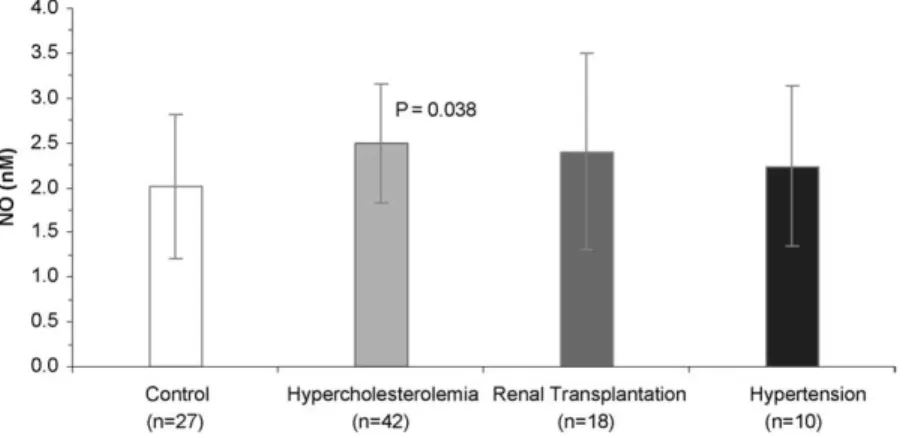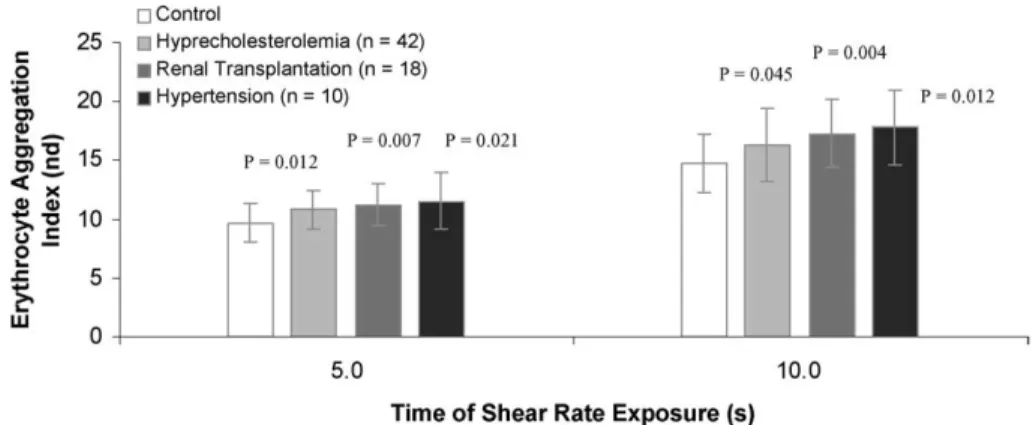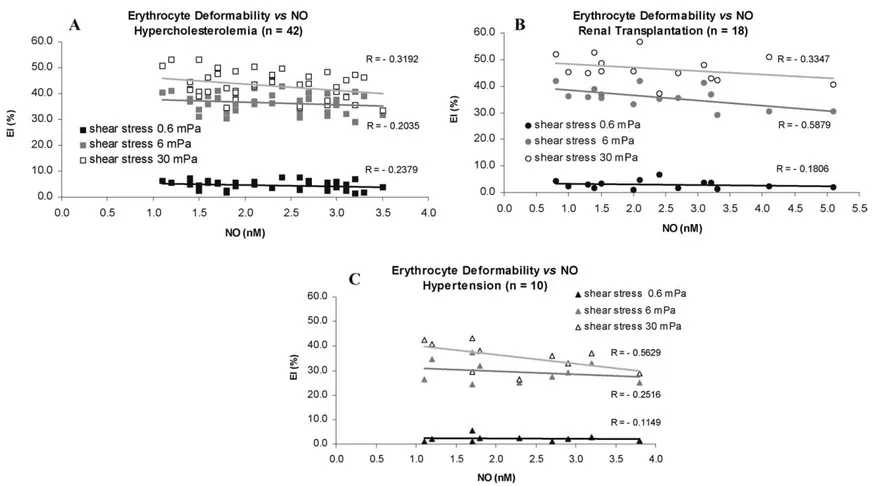IOS Press
The relation between the erythrocyte nitric
oxide and hemorheological parameters
F.A. Carvalhoa,∗, A.V. Mariab, J.M. Braz Nogueirac, J. Guerrad, J. Martins-Silvaa
and C. Saldanhaa
aInstituto de Biopatologia Química, Unidade de Biopatologia Vascular – Instituto de Medicina
Molecular, Faculdade de Medicina de Lisboa, 1649-028 Lisboa, Portugal
bInstituto de Medicina Preventiva, Faculdade de Medicina de Lisboa, 1649-028 Lisboa, Portugal cServiço de Medicina I, Hospital de Santa Maria, 1649-028 Lisboa, Portugal
dServiço de Nefrologia, Hospital de Santa Maria, 1649-028 Lisboa, Portugal
Abstract. We stimulated human erythrocytes obtained from patients with hypercholesterolemia (HC; n = 42), renal trans-plantation (RT; n = 18) and hypertension (HT; n = 10) with acetylcholine (ACh 10 µM) and measured the amperometric NO production, comparing with the NO levels achieved on erythrocytes of healthy persons (n = 27). We also measured the hemoglobin, hematocrit, erythrocyte aggregation, erythrocyte deformability, plasma viscosity and fibrinogen concentration from human blood samples. The erythrocytes NO levels were of 2.5± 0.7 nM (P = 0.038, HC), 2.4 ± 1.1 nM (RT) and 2.2± 0.8 nM (HT) against the 2.0 ± 0.8 nM for the control groups. For each group and at each shear stress value, the ery-throcytes deformability decreases with the increase of the NO concentration after ACh stimulation. We observed a significant increase of the control values on the erythrocyte aggregation results on each patient group. Besides the lower erythrocyte de-formability obtained on HC, RT and HT blood samples, the erythrocytes produced higher NO levels after ACh stimulation than the healthy ones. The power of erythrocyte hemorheological behaviour could be compensated by the NO production at the presence of acetylcholine. We can hypothesises that cholinergic drugs could be used as co-adjuvants of specific therapeutics compounds on these studied diseases.
Keywords: Nitric oxide, hemorheology, acetylcholine, hypertension, hypercholesterolemia, renal transplantation
1. Introduction
Several endothelium-derived substances have been isolated causing smooth muscle relaxation. Nitric oxide is one of them and its biosynthesis pathway is well characterized [1,2]. Nitric oxide is a relatively stable gas, with ability to diffuse through the cell membrane [2]. Reaction of vascular-derived NO with hemoglobin is believed to be the most important pathway for limiting NO bioactivity. The reaction of the iron-containing heme groups of oxy- and deoxyhemoglobin with NO produces, respectively, methe-moglobin and nitrate ions and iron-nitrosyl-hemethe-moglobin [3]. The process of NO diffusion through the cell membrane followed by diffusion through plasma and the chemical reaction with erythrocyte inter-nal hemoglobin indicates that changes in membrane permeability and in other hemorheological parame-ters could occur [4,5]. The changes in hemorheologic properties of the erythrocytes have physiological relevance because they induce modifications in blood viscosity, modulate blood distribution in several *Corresponding author: Filomena A. Carvalho, Instituto de Biopatologia Química, Faculdade de Medicina de Lisboa,
Edifício Egas Moniz, Av. Prof. Egas Moniz, 1649-028 Lisboa, Portugal. E-mail: filomenacarvalho@fm.ul.pt.
342 F.A. Carvalho et al. / The relation between the erythrocyte nitric oxide and hemorheological parameters
vascular territories and tissue oxygenation [6]. Erythrocytes may release NO bound to hemoglobin in the microcirculation under low oxygen tension [7]. In 1980, Furchgott and Zawadzki reported that acetyl-choline (ACh) causes relaxation of isolated blood vessels only in presence of an intact endothelial cell layer [8]. Acetylcholine infusions to forearm blood flow are used to evaluate the endothelial cells lay-ers function [9]. This vasomotor response is NO dependent and the loss of its biological activity and biosynthesis is one of the mechanisms responsible of endothelial dysfunction. Depressed endothelium dependent vascular relaxation is present in patients with essential hypertension [10,11]. Atherosclerosis, hypertension, diabetes, reperfusion injury and vasculopathy as well as angioplasty, bypass surgery, and transplantation are examples of diseases where NO insufficiency induces endothelium dysfunction [12]. There is increasing evidence of associations between hemorheological parameters and hypertension [13]. The development of hypertension in patients submitted to renal transplantation is also described [14]. Our previous in vitro studies shown that ACh decrease erythrocyte aggregation, increase erythrocyte deformability and decrease hemoglobin affinity to oxygen [2]. Here we study the relation between the NO production, achieved by in vitro erythrocyte ACh stimulation, and the changes on hemorheological parameters, in blood from patients with hypercholesterolemia, renal transplantation and hypertension.
2. Materials and methods
The hypercholesterolemic patients (n = 42) were 25 females and 17 males with the mean age of 52 years (SD = 13). The patients that were submitted to a renal transplantation (n = 18) have the mean age of 39 years (SD = 15) and were 8 females and 10 males. The patients with hypertension (n = 10) were 6 females and 4 males with the mean age of 56 years (SD = 8). The mean ages of the controls (healthy persons, n = 27) was 34 years (SD = 7) and were 10 females and 17 males. All the subjects gave their informed consent to participate in this study. We used the amiNO-IV sensor (Innovative Instruments, Inc., FL, USA) to quantify the erythrocytes NO production and the method was described at Carvalho et al. [15]. The erythrocyte deformability was measured at 22◦C using the Rheodyn SSD laser diffractometer (Myrenne, Roetgen, Germany [16]). The erythrocyte aggregation was measured at 22◦C with a MA1 aggregometer (Myrenne, Roetgen, Germany). The plasma viscosity of the samples was measured using a capillary viscometer (Coulter Electronics, Luton, UK) according to the Harkness method [17]. The fibrinogen concentration was measured in a Fibrintimer (Behring Institute, Newark, USA), using a modification of the Clauss’s method. Statistical significances were examined using Student’s t tests, for paired observations, performed with use of the SPSS 10. All patient samples were tested against the control. Statistical significance was considered for values of P < 0.05. The results are presented as means± SD (standard deviation).
3. Results
The NO concentration values obtained from in vitro erythrocytes stimulation with ACh 10 µM are described in Fig. 1. The results in Table 1 revealed that there were no significant difference between the hemoglobin and the hematocrit values of the patients groups and the control group. The erythrocyte deformability of the patients groups decreased the control values, at each shear stress values (vd Fig. 2). For each group and at each shear stress value, the erythrocytes deformability decreases with the increase of the NO concentration after ACh stimulation (vd. Fig. 4). The erythrocyte aggregation values for each patient group significant increased the control values (vd. Fig. 3). The plasma viscosity results (Table 1)
Fig. 1. Nitric oxide concentrations of erythrocytes suspensions (Ht = 0.05%) after in vitro erythrocytes stimulation with ACh 10 µM. Comparation of the NO values between hypercholesterolemic, renal transplantation or hypertension patients and the control (healthy persons). Values are in mean± SD.
Table 1
Hemoglobin (g/dl), hematocrit (%), plasma viscosity (mPa.s) and fibrinogen concentration (mg/dl), of hypercholesterolemic, renal transplantation, hypertension and control (healthy persons) blood samples. Values are in mean± SD
Groups Hb Ht Plasma viscosity Fibrinogen
(g/dl) (%) (mPa.s) (mg/dl)
Control (n = 27) 13.7± 1.2 43.0± 3.6 1.24± 0.04 273.7± 55.4
Hypercholesterolemia (n = 42) 13.9± 1.2 42.5± 3.5 1.26± 1.041 310.0± 64.74 Renal transplantation (n = 18) 13.2± 1.8 41.2± 4.9 1.26± 0.042 294.0± 65.0 Hypertension (n = 10) 14.5± 1.3 42.9± 3.8 1.27± 0.033 287.0± 65.0
1Significant difference relatively to the control samples (P = 0.035);2Significant difference relatively to the control samples
(P = 0.045);3Significant difference relatively to the control samples (P = 0.034);4Significant difference relatively to the control samples (P = 0.027).
Fig. 2. Erythrocyte deformability at shear stress values of 0.6, 6 and 30 mPa, of patients with hypercholesterolemia, renal transplantation and hypertension versus control values. Values are in mean± SD.
344 F.A. Carvalho et al. / The relation between the erythrocyte nitric oxide and hemorheological parameters
Fig. 3. Erythrocyte aggregation of patients with hypercholesterolemia, renal transplantation and hypertension versus control values. The erythrocyte aggregation was measured at 5 and 10 seconds of shear rate exposure. Values are in mean± SD.
showed a significant increase of control values for the HC, RT and HT group. For HC group, there was a significant increase of the fibrinogen concentration control values (vd. Table 1).
4. Discussion
In this study, we observed the relation between the erythrocyte NO production and the changes of hemorheological properties in patients with hypercholesterolemia, renal transplantation and hyperten-sion. In each of these dysfunctions, there was an increase in erythrocytes NO production after in vitro ACh stimulation, although only in the hypercholesterolemic group these results were significant. Re-cent studies suggested that LDL might inhibit endothelium-dependent relaxation through inactivation of NO [18]. In addition, oxidized LDL forms specifically impair NO-dependent arterial relaxation through different mechanisms [19]. Our results showed that on hypercholesterolemic patients, there were signifi-cant increases on erythrocyte aggregation, plasma viscosity and fibrinogen concentration and a decrease on erythrocyte deformability. Previous reports showed that enrichment of cholesterol/phospholipids in-crease erythrocyte suspensions viscosity and dein-crease erythrocyte deformability [20]. From our results of hypercholesterolemic patients (vd. Figs 1–4), we can predict that physiological repercussions of a higher erythrocyte aggregation increased and a lower erythrocyte are attenuated with changes on ery-throcytes NO production or vice versa. Eryery-throcytes were able to produce high NO levels even when erythrocyte deformability is decreased and low NO concentrations when erythrocyte aggregation is in-creased (vd. Fig. 4). The results of renal transplantation patients revealed that there was an inin-creased of the erythrocyte aggregation and plasma viscosity and a decreased of erythrocyte deformability values (vd. Figs 2, 3 and Table 1), which were in accordance with the work of Linde et al. [21]. The changes on hemorheological parameters and on NO concentration may play an important role on the develop-ment of a hypertensive state [22], that can suggest a future target for vasodilating therapeutic action on a microcirculatory network, damaged by different sorts of stimulus. A vascular response to acetylcholine could be modulated by blood pressure normalization [23]. In rat mesenteric resistance arteries, hyperten-sion was associated with an increased of NO oxidation by O¯·2, whereas NO production remained largely unaffected [24]. During hypertension due to aortic banding, a slightly increased of endothelial NOS expression was found [25]. Our hemorheological results were in accordance with other authors, which
Carvalho et al. / The relation b etween the erythr o cyte n itric oxide and hemorheolo gical par ameter s 345
Fig. 4. Values of erythrocyte deformability at shear stress values of 0.6 Pa, 6 Pa and 30 Pa of hypercholesterolemic (A), renal transplantation (B) and hypertensive (C) patients.
346 F.A. Carvalho et al. / The relation between the erythrocyte nitric oxide and hemorheological parameters
showed that the blood and plasma viscosities and erythrocyte aggregation were increased, while erythro-cyte deformability decreased, on hypertension patients [26,27]. In agreement with these results, we may suppose that the erythrocyte aggregation of hypertension group could be related with changes on ery-throcytes NO production. There was a higher tendency to eryery-throcytes aggregate and lower ability to NO production, after ACh stimulation. The hypothesis that acetylcholine, besides its different physiological functions, could participate in transmembrane signalling process, inducing changes on NO production simultaneously with perturbations in aggregation/disaggregation forces and facilitating the erythrocyte deformability, are still unclear. The power of erythrocyte hemorheological behaviour could be compen-sated by the NO production at the presence of acetylcholine. We could hypothesize that cholinergic drugs could be used as co-adjuvants of specific therapeutics compounds in hypercholesterolemia, renal transplantation and hypertension diseases.
Acknowledgements
The authors are grateful to Mrs Teresa Freitas and Mrs Carmo Fernandes for their technical support. This work was supported by “Fundação para a Ciência e Tecnologia”, Portugal.
References
[1] P.M. Vanhoutte, ed., Existence of multiple endothelium-derived relaxing factors, in: Endothelium-derived Hyperpolarizing Factor, Vol. I, Harwood Academic Publishers, France, 1996.
[2] C. Nathan and Q.W. Xie, Regulation of the biosynthesis of nitric oxide, J. Biol. Chem. 269 (1994), 13725–13728. [3] M.T. Gladwin, J.H. Crawford and R.P. Patel, The biochemistry of nitric oxide, nitrite and hemoglobin: role in blood flow
regulation, Free Rad. Biol. & Med. 36(6) (2004), 707–717.
[4] A.J. Gow and J.S. Stamler, Reactions between nitric oxide and haemoglobin under physiological conditions, Nature 391(8) (1998), 169.
[5] R. Mesquita, I. Pires, C. Saldanha and J. Martins-Silva, Effects of acetylcholine and spermineNONOate on erythrocyte hemorheologic and oxygen carrying properties, Clin. Hemorheol. Microcirc. 25(3–4) (2001), 153–163.
[6] G. Mchedlishvilli, Disturbed blood flow structuring as critical factor of hemorheological disorders in microcirculation, Clin. Hemorheol. Microcirc. 19 (1998), 315–325.
[7] L. Jia, C. Bonaventura, J. Bonaventura and J.S. Stamler, S-nitrosohaemoglobin: a dynamic activity of blood involved in vascular control, Nature 380(6571) (1996), 221–226.
[8] R.F. Furchgott and J.V. Zawadski, The obligatory role of endothelial cells in the relaxation of arterial smooth muscle by acetylcholine, Nature 288 (1980), 373–376.
[9] M. Berghoff, M. Kathpal, S. Kilo, M.J. Hilz and R. Freeman, Vascular and neural mechanisms of ACh-mediated vasodi-lation in the forearm cutaneous microcircuvasodi-lation, J. Appl. Physiol. 92(2) (2002) 780–788.
[10] J.A. Panza, A.A. Quyyumi, J.E. Brush, Jr. and S.E. Epstein, Abnormal endothelium-dependent vascular relaxation in patients with essential hypertension, N. Engl. J. Med. 323(1) (1990) 22–27.
[11] S. Taddei, A. Virdis, P. Mattei, F. Arzilli and A. Salvetti, Endothelium-dependent forearm vasodilation is reduced in normotensive subjects with familial history of hypertension, J. Cardiovasc. Pharmacol. 20(Suppl. 12) (1992), S193–195. [12] S.S. Gross and M.S. Wolin, Nitric oxide: pathophysiological mechanisms, Annu. Ver. Physiol. 57 (1995), 737–769. [13] H.J. Meiselman, Hemorheologic alterations in hypertension: chicken or egg?, Clin. Hemorheol. Microcirc. 21 (1999),
195–200.
[14] P.T. McEnery, D.M. Stablein, G. Arbus and A. Tejani, Renal transplantation in children. A report of the North American Pediatric Renal Transplant Cooperative Study, N. Engl. J. Med. 326(26) (1992), 1727–1732.
[15] F.A. Carvalho, J. Martins-Silva and C. Saldanha, Amperometric measurements of nitric oxide in erythrocytes, Biosen. Bioelect. 20 (2004), 505–508.
[16] Guidelines for measurement of blood viscosity and erythrocyte deformability. International Committee for Standardization in Haematology. Expert panel on blood rheology, Clin. Hemorheol. 6 (1986), 439–453.
[17] J. Harkness, A new instrument for measurement of plasma viscosity, Lancet 16 (1963), 280–281.
[18] M. Jacobs, F. Plane and K.R. Bruckdorfer, Native and oxidized low-density lipoproteins have different inhibitory effects on endothelium-derived relaxing factor in the rabbit aorta, Br. J. Pharmacol. 100 (1990) 21–26.
[19] R. Wever, E. Stoes and T.J. Rabelink, Nitric oxide and hypercholesterolemia: a matter of oxidation and reduction?, Atherosclerosis 137(Suppl.) (1998), 51s–60s.
[20] T. Shiga and N. Maeda, Influence of membrane fluidity on erythrocyte functions, Biorheology 17 (1980), 485–499. [21] T. Linde, B. Sandhagen, U. Backman et al., Altered flow properties of blood and increased plasma fibrinogen in
cyclosporine-treated renal allograft recipients, Nephrol. Dial. Transplant. 14 (1999), 1525.
[22] F. Moreso, D. Seron, A.I. Anunciada, M. Hueso, J.M. Ramon, X. Fulladosa, S. Gil-Vernet, J. Alsina and J.M. Grinyo, Recipient body surface area as a predictor of posttransplant renal allograft evolution, Transplantation 65(5) (1998), 671– 676.
[23] D. Rizzoni, E. Porteri, M. Castellano et al., Vascular hypertrophy and remodelling in secondary hypertension, Hyperten-sion 28 (1996), 785–790.
[24] M.R. Tschudi, S. Mesaros, T.F. Lüscher and T. Malinski, Direct in situ measurement of nitric oxide in mesenteric resis-tance arteries. Increased decomposition by superoxide in hypertension, Hypertension 27 (1996), 32–35.
[25] G. Bouloumie, I. Fleming and R. Busse, Endothelial dysfunction coincides with an enhanced NO synthase expression and superoxide anion production, Hypertension 30 (1997), 934–941.
[26] G. Hacioglu, O.Yalcin, M. Bor-Kucukatay, G. Ozkaya and O.K. Baskurt, Red blood cell rheological properties in various rat hypertension models, Clin. Hemorhol. Microcirc. 26 (2002), 27–32.
[27] J. Freitas, J. Braz-Nogueira, J. Nogueira da Costa and J. Martins e Silva, Whole blood filterability and blood oxygen transport in human hypertension, Clin. Hemorheol. 3 (1983), 367–373.


